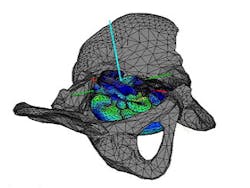Software predicts birthing difficulties
French researchers have developed computer software that can analyze magnetic resonance images (MRIs) of a fetus to help physicians assess whether a woman might have a difficult childbirth.
Because a woman's birth canal is curved and not much wider than a fetus's head, a baby must move through the canal in a specific sequence of maneuvers. A failure in the process, such as a head turned the wrong way at the wrong time, can result in dystocia, or difficult labor.
Using the new Predibirth software, Dr. Olivier Ami -- an obstetrician in the Department of Radiology atAntoine Béclères Hospital, Université Paris Sud (Paris, France) -- and a team of researchers processed MRIs of 24 pregnant women.
The result was a3-D reconstruction of both the pelvis and the fetus along with 72 possible trajectories of the baby's head through the birth canal. Based on these simulations, the program scored each mother's likelihood of a normal birth.
For purposes of the study, the Predibirth scores were computed retrospectively and measured against delivery outcomes for the 24 women. Thirteen women delivered normally. These deliveries were scored as highly favorable by the simulator. Three women who delivered by elective cesarean-section (C-section) -- two of which involved babies of excessive weight -- were scored at high risk for dystocia.
Of the five women delivered by emergency C-section, two involved heart rhythm abnormalities and were scored mildly favorable and favorable. Three involved obstructed labor, all of whom scored at high risk of dystocia. Three women delivered with vacuum extraction and had mildly favorable simulator scores.
"The results in predicting dystocia were highly accurate," Dr. Ami says. "Oursimulation predictions seem to be a significant improvement over pelvimetry, which measures the pelvis manually or by imaging to determine its adequacy for childbirth."
Results of the study were presented at the annual meeting of the Radiological Society of North America (RSNA).
-- By Dave Wilson, Senior Editor,Vision Systems Design
